7 Best Speech to Text Medical Software in 2025
Boost Your Medical Documentation with Speech to Text
Tired of tedious medical documentation? This list of top speech to text medical software solutions will help you reclaim valuable time. Learn about seven powerful tools to streamline your workflow, improve the accuracy of your records, and spend more time focused on patient care. We'll cover key features of Whisperit, Dragon Medical One, M*Modal Fluency Direct, Philips SpeechLive, Dolbey Fusion Narrate, nVoq SayIt, and Voicebrook VoiceOver so you can choose the best speech to text medical solution for your needs.
1. Whisperit
Whisperit stands out as a powerful AI-driven speech to text medical solution, although its primary focus is supporting legal, healthcare, and security professionals with robust dictation and document management capabilities. Beyond its legal prowess, Whisperit's sophisticated voice recognition, transcription, and editing features offer significant benefits for healthcare providers grappling with heavy documentation demands. Imagine effortlessly converting patient consultations, diagnostic notes, and treatment plans into accurate, structured text – freeing up valuable time for patient care. This advanced platform enables users to create, analyze, and research documents up to three times faster than traditional methods, drastically reducing the administrative burden in busy medical environments.
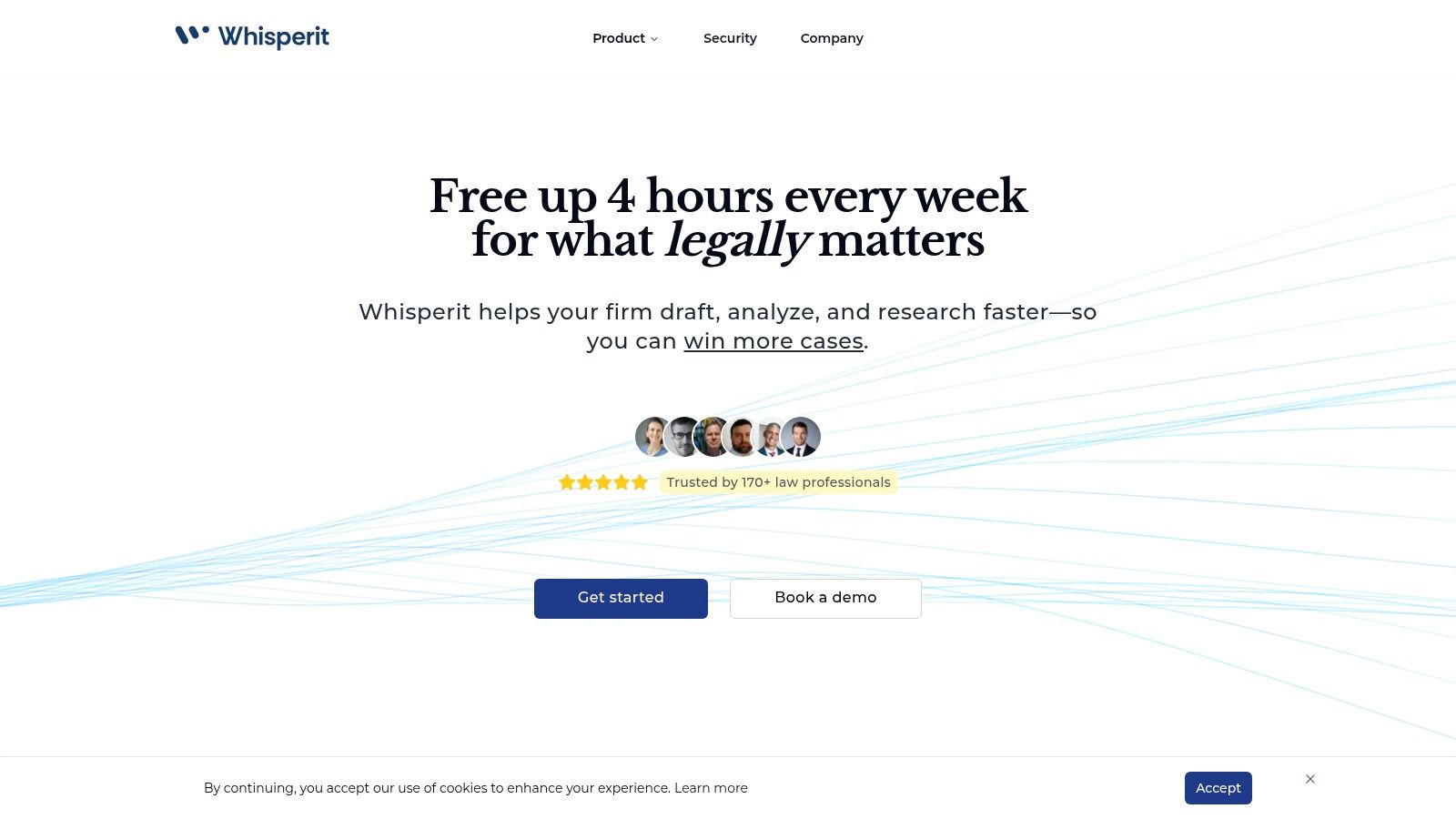
Specifically for medical professionals, Whisperit's speech to text medical functionality can streamline workflows in several ways. Physicians can dictate patient notes directly into the platform, eliminating the need for manual transcription and reducing the risk of errors. This also allows for more comprehensive and detailed record-keeping, as doctors can capture nuances and observations in real-time. The speaker recognition feature further enhances accuracy and personalization. Furthermore, customizable templates can be created for various medical specialties, ensuring consistent and structured documentation across the practice. Learn more about Whisperit in their dedicated medical article: Learn more about Whisperit.
Whisperit boasts robust security measures, including Swiss-based servers, encryption, and GDPR & SOC 2 compliance, crucial for protecting sensitive patient information. Real-time collaboration features also facilitate seamless communication and information sharing among healthcare teams. While pricing details are not readily available and require contacting Whisperit directly, the potential ROI is significant, particularly for larger practices. A cited example shows a 10-lawyer firm (billing CHF 400/hr) potentially saving up to CHF 750,000 annually. While primarily optimized for legal professionals, its core features of accurate speech to text, efficient document management, and top-tier security translate well to the healthcare sector.
Pros:
- Accelerates document creation and case analysis up to 3x faster using AI-powered dictation and transcription.
- Enhances productivity by automating time-consuming tasks like transcription, proofreading, and research.
- Ensures top-tier data security with Swiss-based hosting, encryption, and GDPR & SOC 2 compliance.
- Supports real-time collaboration and customizable workflows tailored to legal and other professional sectors.
- Proven ROI with substantial time and cost savings, trusted by 170+ legal professionals and highly rated by users.
Cons:
- Pricing details are not explicitly listed publicly and may require a demo or contact for tailored quotes.
- Primarily optimized for legal professionals, so some specialized medical features may be less developed.
Website: https://whisperit.ai
2. Dragon Medical One
Dragon Medical One stands out as a leading choice for speech to text medical dictation, specifically designed to address the documentation needs of healthcare professionals. This cloud-based solution from Nuance empowers clinicians to seamlessly translate spoken words into text directly within their Electronic Health Records (EHRs), using voice commands for navigation and input. Its sophisticated deep learning algorithms provide a remarkable level of accuracy (up to 99%) for medical terminology, even without extensive initial training. This positions Dragon Medical One as a powerful tool for boosting efficiency and streamlining workflows in various healthcare settings.
Practical Applications and Use Cases:
Dragon Medical One shines in situations requiring rapid and accurate medical documentation. Consider these examples:
- Clinician Documentation: Physicians, nurses, and other healthcare providers can use voice dictation to efficiently document patient encounters, create progress notes, compose referral letters, and complete other documentation tasks directly in the EHR. This reduces time spent on manual data entry and allows more focused patient interaction.
- Surgical Reports: Surgeons can dictate operative reports in real-time, capturing critical details accurately and efficiently during or immediately after a procedure. This minimizes delays in documentation and ensures comprehensive records.
- Telehealth Consultations: The hands-free nature of speech to text medical software like Dragon Medical One is ideal for telehealth consultations, allowing providers to maintain eye contact with patients while simultaneously documenting the encounter.
- Medical Research: Researchers can leverage Dragon Medical One to transcribe interviews, analyze qualitative data from patient narratives, and efficiently document research findings.
Features and Benefits:
- Cloud-Based Architecture: This eliminates the need for complex on-site installations and ensures automatic updates, simplifying maintenance and ensuring access to the latest features.
- Specialized Medical Vocabulary: Covering over 90 medical specialties and subspecialties, Dragon Medical One boasts an extensive lexicon that understands intricate medical terminology, minimizing errors and the need for laborious corrections.
- EHR Integration: Seamless integration with prominent EHR systems like Epic, Cerner, and Allscripts allows for direct dictation into patient records, minimizing workflow disruptions and improving data accuracy.
- Continuous Learning: The software's deep learning capabilities enable it to adapt to individual clinician voices and frequently used terminology, constantly improving accuracy and personalized performance.
- Voice-Enabled Commands: Navigate within applications and execute commands using voice control, further enhancing efficiency and streamlining tasks.
Pros:
- High Accuracy: Achieves exceptional accuracy with medical terminology, reducing the need for time-consuming corrections and improving the quality of documentation.
- Time Savings: Offers the potential to save clinicians up to 2 hours per day, freeing up valuable time for patient care and other essential tasks.
- Single Voice Profile: A consistent voice profile travels with the clinician across different devices and locations, ensuring a seamless experience wherever they work.
- HIPAA Compliant: Robust security features ensure compliance with HIPAA regulations, safeguarding sensitive patient data.
Cons:
- Pricing: The premium pricing model can be a significant investment, potentially posing a challenge for smaller practices with limited budgets.
- Internet Dependency: Reliable internet connectivity is essential for optimal functionality, as it's a cloud-based solution. Offline dictation is not possible.
- Workflow Adjustments: Implementation may require adjustments to existing workflows, potentially causing temporary disruption during the transition.
- Occasional Latency: Some users have reported occasional latency issues, which can be frustrating during real-time dictation.
Pricing and Technical Requirements:
Contact Nuance directly for detailed pricing information, as it varies based on practice size and specific needs. Technical requirements primarily involve a compatible computer, a reliable internet connection, and a high-quality microphone.
Implementation Tips:
- Training: While not extensive, some initial training on the software's features and voice commands is recommended for optimal utilization.
- Microphone Selection: Investing in a high-quality noise-canceling microphone can significantly improve accuracy and reduce transcription errors.
- Workflow Integration: Carefully plan the integration of Dragon Medical One into existing workflows to minimize disruptions and maximize efficiency gains.
Website: https://www.nuance.com/healthcare/provider-solutions/speech-recognition/dragon-medical-one.html
Dragon Medical One's robust features, high accuracy for speech to text medical applications, and seamless EHR integrations justify its place as a leading solution in this list. While the cost might be a barrier for some, its potential for significantly improving efficiency and reducing documentation burdens makes it a compelling option for healthcare providers seeking to optimize their workflows.
3. M*Modal Fluency Direct
M_Modal Fluency Direct, now integrated into 3M's healthcare solutions, stands out as a leading speech to text medical solution designed specifically for the demanding needs of healthcare professionals. This real-time, conversational speech recognition technology empowers physicians to seamlessly create and edit clinical documentation directly within their Electronic Health Record (EHR) systems. By leveraging advanced natural language understanding, M_Modal Fluency Direct accurately captures the nuances of patient encounters, transforming spoken words into structured medical data. This allows physicians to focus on patient care while simultaneously completing necessary documentation, improving both efficiency and accuracy.
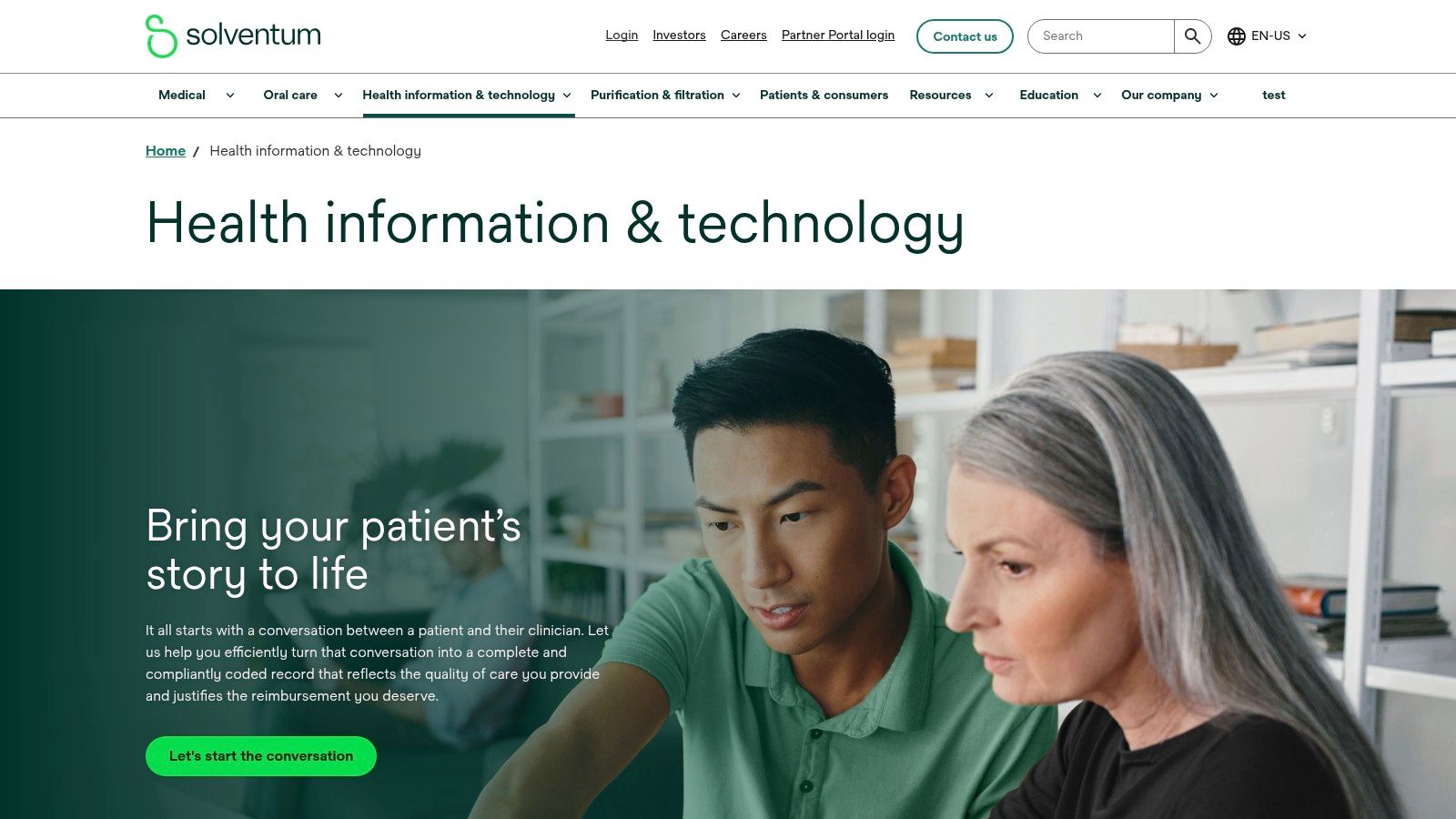
A key strength of M*Modal Fluency Direct is its deep integration with over 200 EHR systems. This front-end integration means physicians can navigate and control their EHR using voice commands, streamlining workflows and minimizing disruptions. Imagine being able to pull up patient charts, input vital signs, or order medications all through voice commands. This hands-free functionality not only saves time but also reduces the risk of errors associated with manual data entry. Furthermore, its Computer-Assisted Physician Documentation (CAPD) provides real-time feedback and suggestions for improving clinical documentation, ensuring compliance and completeness.
For legal professionals, secure and accurate medical documentation is paramount. M_Modal Fluency Direct's focus on accuracy and HIPAA compliance makes it a valuable tool for generating reliable transcripts for legal proceedings. Learn more about M_Modal Fluency Direct and its relevance to HIPAA-compliant transcription. Healthcare providers benefit from improved documentation efficiency and reduced administrative burden, allowing for more focused patient care. Security and Compliance Officers can rely on the platform’s robust security features and adherence to industry regulations.
Key Features & Benefits:
- Real-Time Speech Recognition: Dictate directly into the EHR, eliminating transcription delays.
- Advanced Clinical Language Understanding (CLU): Accurately interprets complex medical terminology.
- Computer-Assisted Physician Documentation (CAPD): Provides real-time feedback and suggestions for documentation improvement.
- Mobility: Smartphone apps allow for dictation and access from anywhere.
- Voice Navigation & Commands: Control EHR systems hands-free using voice commands.
Pros:
- Exceptional Accuracy: Specialized medical vocabularies ensure accurate transcriptions.
- Real-Time Feedback: CAPD helps improve documentation quality and compliance.
- Easy to Learn: Minimal training required to get started.
- Cross-Device Compatibility: Speech profiles work seamlessly across multiple devices.
Cons:
- Complex Implementation: Full EHR integration can be a complex process.
- Higher Cost: More expensive than general-purpose speech to text software.
- Occasional Performance Issues: Some users report issues with larger dictations.
- Advanced Features Require Training: Full utilization of advanced features requires more extensive training.
While pricing and specific technical requirements for M*Modal Fluency Direct are not readily available publicly, it's essential to contact 3M directly for detailed information and a customized quote based on your organization's specific needs.
M*Modal Fluency Direct distinguishes itself from general-purpose speech to text tools through its specialized focus on medical terminology and deep EHR integration. This focus on the healthcare industry makes it a powerful tool for improving documentation efficiency, accuracy, and compliance. While the implementation process might be more complex and the cost higher compared to general speech to text options, the benefits for healthcare professionals, particularly in terms of time savings and improved documentation quality, make it a valuable investment for organizations seeking to optimize their clinical workflows.
4. Philips SpeechLive
Philips SpeechLive is a robust cloud-based dictation and transcription solution that leverages speech to text medical capabilities, making it a valuable tool for healthcare professionals. It offers a flexible platform for managing medical documentation, from initial dictation capture through transcription and final document management. This system allows physicians, nurses, and other healthcare providers to create reports, notes, and other essential documents using voice, freeing up their hands and potentially streamlining their workflow. This is particularly useful for busy professionals who need to capture information quickly and accurately, whether they're in the clinic, hospital, or even on the go.
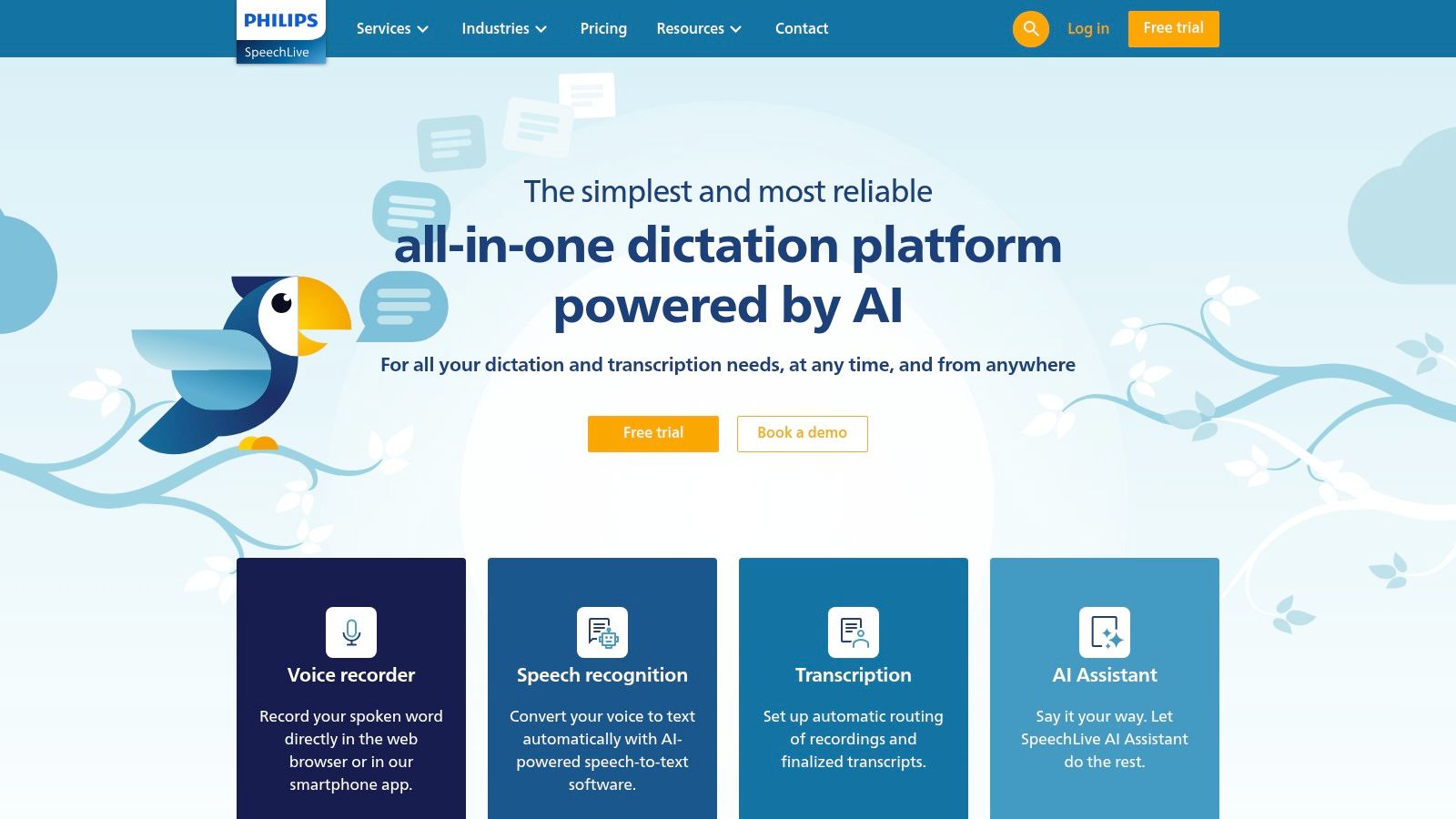
One of the key strengths of Philips SpeechLive is its flexibility. It caters to various input methods, including mobile apps for dictation on smartphones and tablets, a web recorder for use on desktops, and compatibility with traditional dictation devices. This ensures that users can work with the platform regardless of their preferred method of dictation. It also offers a hybrid approach, combining the speed of speech recognition with the accuracy of professional transcription services. This feature allows users to choose the level of service that best suits their needs and budget. For example, a quick note might rely solely on speech recognition, while a complex medical report could benefit from professional transcription.
For healthcare providers specifically, Philips SpeechLive offers specialized medical vocabulary options. This enhances the accuracy of speech to text medical transcription, reducing the need for manual corrections and saving valuable time. While not exclusively designed for healthcare, its customizable workflows can be tailored for different medical specialties, ensuring relevance and efficiency for specific needs. Security and compliance are paramount in healthcare, and Philips SpeechLive addresses this with HIPAA-compliant secure document handling, protecting sensitive patient information. Learn more about Philips SpeechLive to understand how workflow automation, a core aspect of this tool, can further enhance healthcare practices. This resource can provide valuable insights into the benefits of streamlined processes.
While Philips SpeechLive offers numerous advantages, it's important to consider its limitations. The speech recognition accuracy, while boosted by medical vocabulary options, may not be as specialized as dedicated medical speech to text solutions. Additionally, its direct EHR integrations are somewhat limited compared to competitors, potentially requiring workflow modifications for optimal efficiency. Some users have also reported occasional synchronization delays between devices.
Pros:
- Flexible subscription pricing model suitable for practices of all sizes
- Excellent mobile capabilities for dictation on the go
- Hybrid approach combining speech recognition and human transcription
- Intuitive user interface requiring minimal training
Cons:
- Speech recognition accuracy not as specialized as dedicated medical solutions
- Limited direct EHR integrations compared to some competitors
- May require workflow modifications for optimal efficiency
- Some users report synchronization delays between devices
Philips SpeechLive earns its place on this list due to its comprehensive features, flexible workflow options, and commitment to secure data handling. Its adaptable nature makes it a valuable tool for a range of users, from individual practitioners to large healthcare organizations seeking to improve their dictation and transcription processes. While specific pricing and technical requirements are not readily available publicly, interested parties are encouraged to visit the Philips SpeechLive website for detailed information and to determine its suitability for their specific needs.
5. Dolbey Fusion Narrate
Dolbey Fusion Narrate is a robust front-end speech to text medical solution specifically designed to streamline healthcare documentation. It empowers clinicians to create, edit, and sign reports directly within their Electronic Health Record (EHR) system, minimizing manual data entry and maximizing efficiency. Leveraging Nuance's renowned speech recognition engine, Fusion Narrate boasts high accuracy for medical terminology, making it a valuable tool for physicians, nurses, and other healthcare providers.
This platform stands out for its flexible deployment options, catering to diverse organizational needs. It can be deployed via the cloud or on-premises, offering flexibility for healthcare systems of varying sizes and IT infrastructures. Furthermore, Fusion Narrate offers extensive customization capabilities for different medical specialties, ensuring that the software adapts to the unique terminology and workflow requirements of each department, from cardiology to radiology.
One of Fusion Narrate’s key strengths lies in its deep integration with clinical documentation workflows. It supports both traditional dictation and real-time speech to text medical transcription, allowing clinicians to choose the method that best suits their preferences and the specific situation. Features like automated document templating and formatting further enhance efficiency by reducing repetitive tasks. Advanced command and control capabilities allow users to navigate and manipulate documents seamlessly using voice commands, streamlining the entire reporting process.
Practical Applications and Use Cases:
- Generating patient reports: Quickly and accurately dictate patient histories, physical exam findings, diagnoses, and treatment plans.
- Creating discharge summaries: Streamline the discharge process by efficiently dictating comprehensive summaries.
- Documenting surgical procedures: Capture detailed operative notes in real-time, minimizing the administrative burden on surgeons.
- Completing consultation reports: Facilitate timely communication between specialists by enabling rapid creation of consultation reports.
Comparison with Similar Tools:
While Dolbey Fusion Narrate excels in its integration with EHR systems and customizable medical vocabularies, it faces competition from other speech to text medical solutions. Some newer platforms offer more advanced mobile capabilities, which might be a crucial factor for clinicians who frequently work remotely. Market leaders like Dragon Medical One also boast larger user bases and more established community support.
Implementation and Setup Tips:
Implementing Fusion Narrate requires careful planning and coordination with IT staff. Due to its extensive customization options, proper configuration is essential to maximize its effectiveness within a specific healthcare environment. Adequate training for clinicians is also crucial to ensure optimal use and achieve the desired productivity gains. Learn more about Dolbey Fusion Narrate to understand the data security implications of implementing such a system.
Pros:
- High recognition accuracy for medical terminology
- Flexible deployment options (cloud or on-premises)
- Extensive customization capabilities for different specialties
- Strong integration with clinical documentation workflows
Cons:
- Smaller user base compared to market leaders
- Implementation and integration can be complex
- Limited mobile capabilities compared to newer solutions
- Training requirements for optimal use can be significant
Website: https://www.dolbey.com/solutions/dictation-speech-recognition/fusion-narrate/
Dolbey Fusion Narrate deserves its place on this list because it provides a powerful and specialized speech to text medical solution tailored for the complexities of healthcare documentation. Its focus on accuracy, integration, and customizability makes it a valuable asset for healthcare organizations looking to enhance efficiency and reduce the administrative burden on clinicians. While pricing and specific technical requirements aren't readily available, contacting Dolbey directly will provide a personalized assessment of your organization's needs. For security and compliance officers, understanding the data flow and security measures within Fusion Narrate is paramount, especially in the context of protected health information (PHI). This highlights the importance of due diligence during the evaluation and implementation process.
6. nVoq SayIt
nVoq SayIt is a cloud-based speech to text medical solution specifically designed for healthcare organizations of all sizes. It provides real-time speech-to-text capabilities that seamlessly integrate with Electronic Health Record (EHR) systems and other healthcare applications. This makes it a valuable tool for physicians, nurses, and other medical professionals looking to streamline documentation and improve overall workflow efficiency. SayIt prioritizes simplicity, enabling quick implementation and adaptability across various medical specialties with minimal training. This focus on ease of use makes it a practical choice for busy healthcare providers who need a reliable and efficient speech to text medical solution.
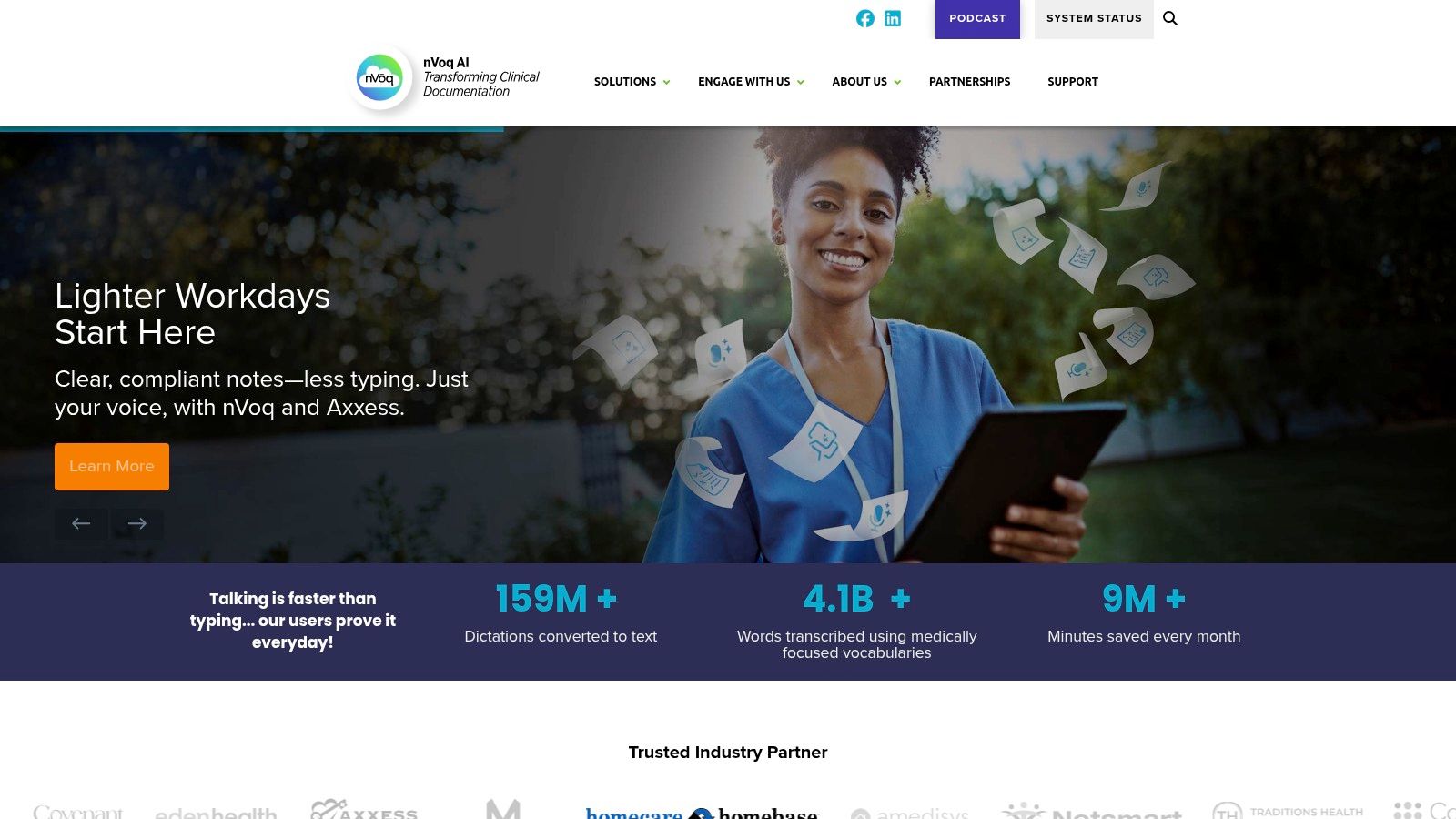
For legal professionals involved in medical malpractice or personal injury cases, accurate and comprehensive medical records are crucial. nVoq SayIt's integration with EHR systems can facilitate the efficient collection and review of medical documentation, aiding in case preparation. Security and Compliance Officers will appreciate the HIPAA-compliant security features, ensuring patient data privacy and adherence to regulatory standards.
Key features of nVoq SayIt include its cloud-based architecture allowing for rapid implementation, specialized medical vocabularies and shorthand capabilities, and seamless integration with leading EHR systems and healthcare applications. The platform also offers text macro capabilities and custom shortcuts, further enhancing efficiency. For example, a physician could create a shortcut for a frequently used phrase like "patient presents with" to significantly reduce dictation time.
Pros:
- Competitive Pricing: nVoq SayIt offers a competitive pricing model, making it a viable option for smaller practices and individual providers.
- Minimal IT Infrastructure: Its cloud-based nature minimizes the need for extensive IT infrastructure and ongoing maintenance.
- Rapid Implementation: SayIt is designed for quick implementation, allowing healthcare providers to realize the benefits of speech to text medical documentation rapidly.
- Strong Support: nVoq provides robust customer support and training resources to ensure users can effectively utilize the platform.
Cons:
- Brand Recognition: nVoq SayIt has less name recognition compared to some of the larger players in the speech recognition market.
- Initial Accuracy: While generally accurate, the speech recognition may require more correction initially as the system adapts to individual speech patterns and specialized terminology.
- Specialty Vocabularies: Compared to premium options, SayIt offers a more limited range of highly specialized medical vocabularies.
- Natural Language Processing: The natural language understanding capabilities are less advanced than some competitors, which might limit its ability to interpret complex medical jargon or free-form dictation.
Website: https://sayit.nvoq.com/
nVoq SayIt earns its place on this list due to its targeted focus on healthcare, ease of use, and competitive pricing. While it may not have all the bells and whistles of some premium solutions, it offers a practical and efficient speech to text medical solution for a wide range of healthcare professionals, legal teams, and compliance officers needing a reliable and secure documentation tool. Specific pricing and technical requirements are available upon request from nVoq. Implementation is typically straightforward, with nVoq providing support and training to ensure a smooth transition. For practices looking for a balanced solution between functionality, ease of use, and affordability, nVoq SayIt is a strong contender in the speech to text medical market.
7. Voicebrook VoiceOver
Voicebrook VoiceOver stands out in the speech to text medical landscape as a highly specialized solution geared towards the intricate demands of pathology reporting, radiology, and other complex medical documentation workflows. Unlike more general speech to text tools, VoiceOver combines advanced speech recognition technology with specialized templates, extensive medical vocabularies, and custom command sets designed specifically for these detail-intensive specialties. This focus allows for exceptional accuracy in transcribing complex medical terminology and protocols, a crucial factor for ensuring accurate diagnoses and treatment plans. For healthcare providers dealing with nuanced medical language, VoiceOver offers a powerful tool for streamlining documentation and minimizing errors.
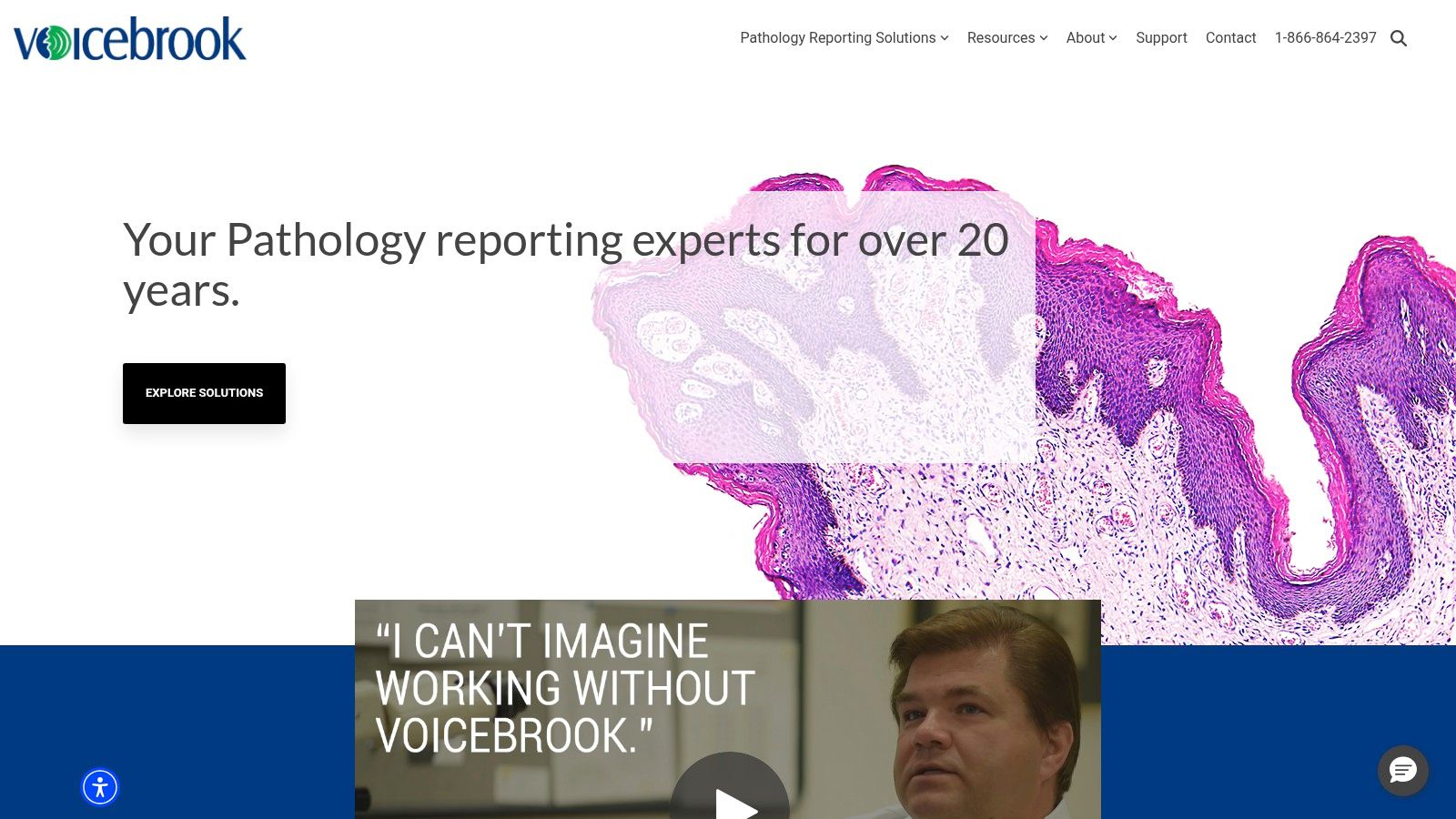
Its structured reporting templates, specifically designed for workflows in anatomic pathology, radiology, and other related fields, significantly boost efficiency and standardize reporting practices. Imagine a pathologist dictating a complex tissue analysis report; VoiceOver’s structured templates guide the dictation process, ensuring all essential elements are captured in a consistent format. This not only reduces the time spent on documentation but also minimizes the risk of omissions or inconsistencies. For security and compliance officers, this standardization is invaluable in maintaining accurate and auditable medical records. The quality assurance tools built into VoiceOver further enhance accuracy by flagging potential errors and providing opportunities for review before finalizing reports. This is particularly important for legal professionals involved in medical malpractice or personal injury cases where accurate documentation is paramount.
While VoiceOver excels in its specialized niche, it’s important to acknowledge its limitations. Its focused design makes it less suitable for general medical documentation needs, unlike broader speech to text medical solutions. Furthermore, as a highly specialized solution, it comes with a higher cost and requires more extensive implementation and training compared to more general tools. Pricing information isn’t publicly available, requiring direct contact with Voicebrook. Technical requirements will also vary depending on the specific implementation and integration needs of the healthcare facility. Learn more about Voicebrook VoiceOver to understand how such transcription tools function in a medical setting.
Implementation tips for VoiceOver include a thorough needs assessment to ensure alignment with the specific requirements of the medical specialty, adequate training for users to maximize the system’s capabilities, and ongoing support from Voicebrook to address any technical or workflow challenges. Despite the higher initial investment and training requirements, the long-term benefits of increased accuracy, efficiency, and standardization in complex medical reporting make VoiceOver a compelling solution for those in specialized fields. This focused approach justifies its place on this list, particularly for those seeking a powerful speech to text solution tailored to the unique demands of pathology, radiology, and other complex medical specialties. By reducing transcription costs and improving turnaround time, VoiceOver offers a valuable return on investment for practices dealing with high volumes of complex medical reports.
Speech-to-Text Medical Tools Comparison
| Product | Core Features & Technology | User Experience & Quality ★★★★★ | Value Proposition 💰 | Target Audience 👥 | Unique Selling Points ✨ |
|---|---|---|---|---|---|
| 🏆 Whisperit | AI dictation, transcription, legal research, Swiss data privacy | ★★★★★ Highly precise, real-time collaboration | High ROI, boosts productivity, time savings | Legal, healthcare, security pros | Swiss hosting, GDPR & SOC 2 compliance, customizable workflows |
| Dragon Medical One | Cloud speech recognition, advanced medical vocab, EHR integration | ★★★★☆ 99% accuracy, adapts to user | Premium pricing, saves 2 hrs/day per clinician | Healthcare professionals | Deep learning, single voice profile across devices |
| M*Modal Fluency Direct | Real-time speech recognition in 200+ EHRs, Clinical Language Understanding | ★★★★☆ Accurate, real-time feedback | Higher cost, minimal training needed | Physicians & clinical staff | Real-time CAPD, voice navigation within EHR |
| Philips SpeechLive | Cloud dictation workflow, multi-input, transcription service | ★★★★☆ Intuitive UI, good mobility | Flexible pricing, hybrid speech + human transcription | Healthcare professionals | Mobile dictation, HIPAA compliant, customizable workflows |
| Dolbey Fusion Narrate | Front-end speech recognition, on-prem/cloud deployment | ★★★★☆ Accurate medical terminology | Complex integration, flexible deployment | Healthcare documentation teams | Extensive customization, automated templating |
| nVoq SayIt | Cloud-based, quick setup, medical vocab & macros | ★★★☆☆ Simple, quick adoption | Competitive pricing, low IT needs | Small to mid-sized healthcare orgs | Fast implementation, text macros |
| Voicebrook VoiceOver | Specialized pathology/radiology speech recognition | ★★★★☆ High accuracy in complex specialties | Costly, niche market | Pathologists, radiologists | Specialty templates, quality assurance tools |
Choosing the Right Speech to Text Medical Software
Selecting the optimal speech to text medical software requires careful consideration of various factors. Throughout this article, we've explored leading solutions, including Whisperit, Dragon Medical One, M*Modal Fluency Direct, Philips SpeechLive, Dolbey Fusion Narrate, nVoq SayIt, and Voicebrook VoiceOver, each offering unique strengths and capabilities. Key takeaways include the importance of accuracy, integration with existing EHR systems, deployment options (cloud-based vs. on-premise), security and compliance features (especially HIPAA compliance), and of course, pricing.
For healthcare providers, the right speech to text solution can significantly reduce documentation time, allowing for more patient-focused care. Legal professionals benefit from streamlined documentation for medical cases, and security and compliance officers can ensure accurate and secure record-keeping. When implementing these tools, prioritize a seamless integration with your current workflow. Consider factors such as the specific needs of your users, the volume of dictation required, and the level of technical support offered by the vendor. In medical call centers, accurate and efficient documentation is crucial. Speech analytics can significantly enhance quality assurance and improve agent performance in these environments. To learn more about leveraging this technology, explore this insightful article on call center speech analytics.
By carefully evaluating the features, pricing, and deployment models of each platform against your specific needs and budget, you can empower your organization with efficient and accurate medical documentation. The future of healthcare documentation is here. Don't wait – embrace the power of speech to text medical software today. Ready to experience the difference? Explore Whisperit, a leading speech to text medical solution designed to streamline your documentation process and improve accuracy. Learn more and request a demo at Whisperit.